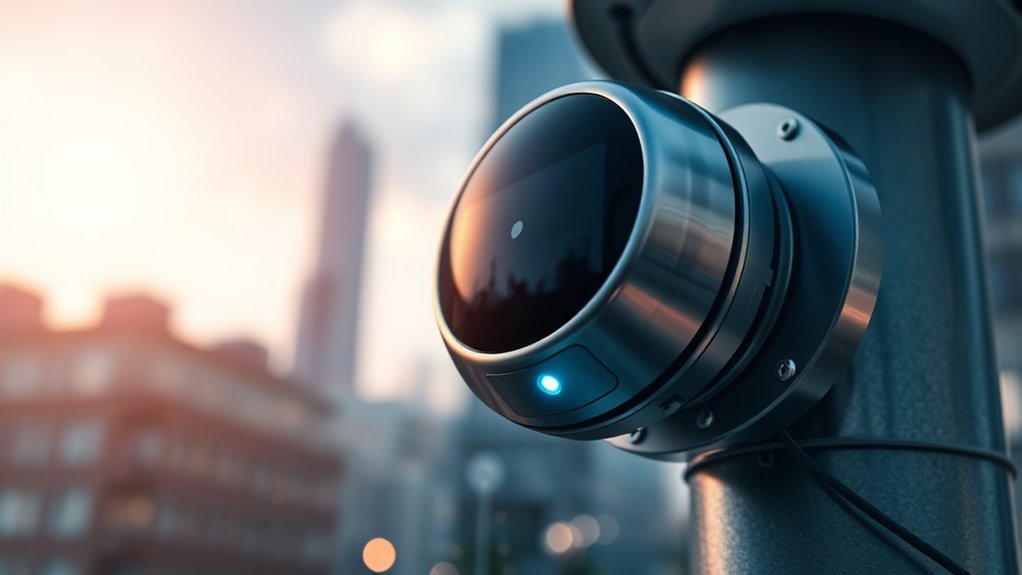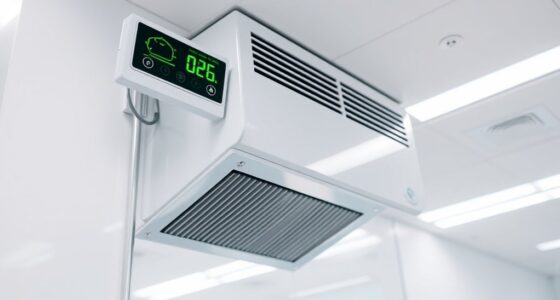To protect your IoT air quality sensors, implement strong network security measures like encrypting data with AES-256 and using secure protocols such as TLS. Segment networks to limit access, and set up intrusion detection systems to monitor for suspicious activity. Regularly update firmware and enforce access controls to prevent unauthorized use. By layering these strategies, you can safeguard your sensors and confirm data remains accurate and trustworthy—continue to explore how these measures work together for total security.
Key Takeaways
- Encrypt data in transit and at rest using robust standards like AES-256 to protect sensitive environmental information.
- Deploy Intrusion Detection Systems to monitor network traffic and detect suspicious activities or potential breaches.
- Segment IoT sensors on separate networks and enforce strict access controls to limit lateral movement and reduce vulnerabilities.
- Use secure communication protocols such as TLS and conduct regular security audits to identify and patch vulnerabilities proactively.
- Implement layered security measures and promote best practices to ensure comprehensive protection of air quality sensor networks.

As the deployment of IoT air quality sensors becomes more widespread, guaranteeing their network security is more critical than ever. These sensors collect essential environmental data that informs public health decisions, but their connectivity exposes them to potential threats. To protect this sensitive information, you need to implement robust security measures that prevent unauthorized access and data breaches. One of the most fundamental strategies is data encryption. By encrypting data in transit and at rest, you make it considerably more difficult for hackers to interpret or manipulate the information if they intercept it. Strong encryption standards, such as AES-256, should be standard practice, ensuring that even if malicious actors gain access to your network, they can’t easily decipher the data being transmitted from your sensors. Alongside data encryption, intrusion detection systems (IDS) play a crucial role in maintaining network security. An IDS continuously monitors your network traffic for suspicious activity or known attack signatures. When it detects anomalies—such as unusual data flows, unexpected access attempts, or irregular sensor behavior—it can alert you immediately, enabling swift action to prevent potential breaches or data tampering. Implementing an effective intrusion detection system means you’re not just reacting to threats after they occur but actively monitoring and identifying vulnerabilities in real time. These systems can be configured to automatically block suspicious traffic or isolate compromised sensors, minimizing damage and ensuring the integrity of your air quality data. You should also consider deploying network segmentation for your IoT sensors. By isolating your sensors on separate network segments, you limit the scope of any breach and prevent attackers from moving laterally across your entire network. This approach, combined with strong password policies and regular firmware updates, further reduces vulnerabilities. Additionally, you need to establish secure communication protocols, such as TLS, to protect data exchanges between sensors and centralized servers. Regularly auditing your network and security configurations is essential too, as it helps you identify and patch vulnerabilities before they’re exploited. Educating your team about security best practices ensures everyone understands their role in maintaining a secure environment. Ultimately, securing IoT air quality sensors requires a layered approach—integrating data encryption, intrusion detection, network segmentation, secure protocols, and ongoing vigilance. By doing so, you safeguard not only the integrity and confidentiality of your environmental data but also the trust of the communities relying on this information for their health and safety. Remember, as these sensors become more embedded in our daily lives, proactive security measures aren’t optional; they’re indispensable for a resilient, trustworthy IoT ecosystem. Incorporating powerful persuasive words can further enhance the effectiveness of your security communications and training efforts.
Frequently Asked Questions
How Can Iot Air Quality Sensors Be Physically Secured Against Tampering?
You can physically secure your IoT air quality sensors by implementing robust safeguards like tamper detection alarms and sturdy enclosures. Use tamper-evident seals or locks to prevent unauthorized access, and position sensors in hard-to-reach areas. Regularly inspect devices for signs of tampering, and consider installing cameras or sensors that alert you immediately if someone tries to interfere. These physical safeguards help guarantee your sensors remain reliable and secure.
What Are the Cost Implications of Implementing Advanced Network Security Measures?
Implementing advanced network security measures is like investing in a sturdy lock for your door—costs can add up quickly. A thorough cost analysis helps you weigh the benefits against your budget considerations, ensuring you don’t overspend. While initial expenses might seem high, the long-term savings in preventing breaches and data loss make it worthwhile. Remember, smart security choices protect your sensors and your peace of mind.
How Does Network Security Impact Sensor Data Latency and Real-Time Analytics?
Network security can somewhat increase data transmission latency due to encryption protocols, but it’s essential for protecting sensor data. When you implement robust security measures, like end-to-end encryption, you ensure data integrity and confidentiality without considerably hindering real-time analytics. While some delay might occur, the benefits of secure data transmission outweigh the minor impacts on sensor data latency, enabling you to make timely, informed decisions based on accurate air quality information.
What Training Is Required for Personnel to Maintain Iot Security Effectively?
To maintain IoT security effectively, you need to undergo thorough training that covers cybersecurity awareness and technical certification. You should stay sharp by sharpening your skills through specialized courses, certifications, and continuous learning. This training helps you understand threats, implement best practices, and respond swiftly to security incidents. By boosting your knowledge and technical expertise, you guarantee robust protection for IoT air quality sensors, securing sensitive data and sustaining system integrity.
Are There Industry Standards Specific to Securing Iot Air Quality Monitoring Networks?
Yes, there are industry standards specific to securing IoT air quality monitoring networks. You should aim for compliance with recognized frameworks like ISO/IEC 27001 and NIST guidelines, which help establish strong security practices. Obtaining security certifications demonstrates your commitment to industry compliance and can improve trustworthiness. Regularly review standards updates and incorporate them into your security protocols to guarantee ongoing protection of your IoT air quality sensors.
Conclusion
You now understand how securing IoT air quality sensors is like locking a door to protect your home. Imagine a city where sensors detect pollution but are left vulnerable—hackers could flood the streets with false readings, like false alarms in a fire drill. By implementing strong security measures, you’re not just safeguarding data; you’re ensuring the air we breathe remains safe. Think of it as building a fortress around our environment, one sensor at a time.










